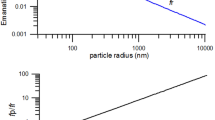Abstract
In order to more accurately predict the rates and mechanisms of radionuclide migration from lowlevel waste disposal facilities via groundwater transport, ongoing studies are being conducted at field sites at Chalk River Laboratories to identify and characterize the chemical speciation of mobile, long-lived radionuclides migrating in groundwaters. Large-volume water sampling techniques are being utilized to separate and concentrate radionuclides into particulate, cationic, anionic, and nonionic chemical forms. Most radionuclides are migrating as soluble, anionic species which appear to be predominately organoradionuclide complexes. Laboratory studies utilizing anion exchange chromatography have separated several anionically complexed radionuclides, e.g.,60Co and106Ru, into a number of specific compounds or groups of compounds. Large-volume ultra-filtration experiments have shown that significant fractions of the radionuclides are being transported in these groundwaters in the form of macromolecules having molecular weights ranging from less than 3,000 to 100,000.
Similar content being viewed by others
References
D. Champ, J. Young, D. Robertson, and K. Abel, Water Pollution Research Journal of Canada, 19 (1985) 35.
R. Killey and J. Munch, Subsurface Contaminant Transport from the Liquid Disposal Area, CRNL-(1)Hydrogeology and Tritium Contamination Near the Chemical Pit: Atomic Energy of Canada Limited Report AECL-7691, 105p (1984).
R. Killey, J. McHugh, D. Champ, E. Cooper and J. Young, Environmental Science and Technology, 18 (1984) 148.
R. Killey and J. Mattie, unpublished data, Chalk River Laboratories, Chalk River, Ontario, Canada KOJIJO, (1993).
D. Robertson and R. Perkins, Radioisotope ratios in characterizing the movement of different physical and chemical species through natural soils, In: Isotope Ratios as Pollutant Source and Behavior Indicators: International Atomic Energy Agency Symposium, Vienna, pp. 123–133, (1974).
A. Schilk, D. Robertson, C. Thomas, E. Lepel, D. Champ, R. Killey, J. Young and E. Cooper, Contaminated Groundwater Characterization at the Chalk River Laboratories, Ontario, Canada, In: Fourteenth Annual U.S. Department of Energy Low-Level Radioactive Waste Management Conference Proceedings: U.S. Department of Energy Conference, Phoenix, pp. 67–83, (1992).
Author information
Authors and Affiliations
Rights and permissions
About this article
Cite this article
Robertson, D.E., Schilk, A.J., Abel, K.H. et al. Chemical speciation of radionuclides migrating in groundwaters. Journal of Radioanalytical and Nuclear Chemistry, Articles 194, 237–252 (1995). https://doi.org/10.1007/BF02038420
Issue Date:
DOI: https://doi.org/10.1007/BF02038420




